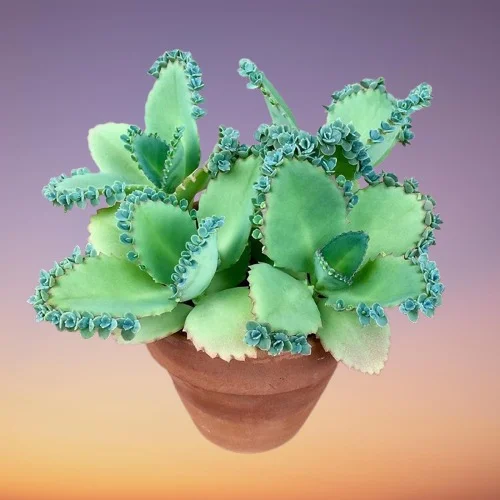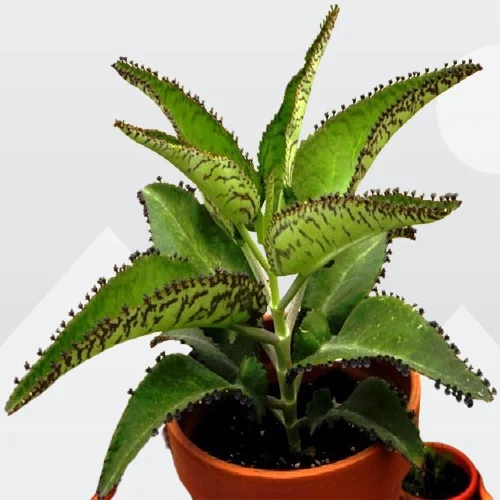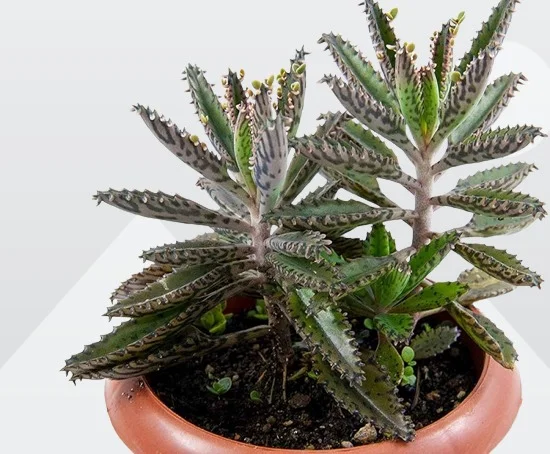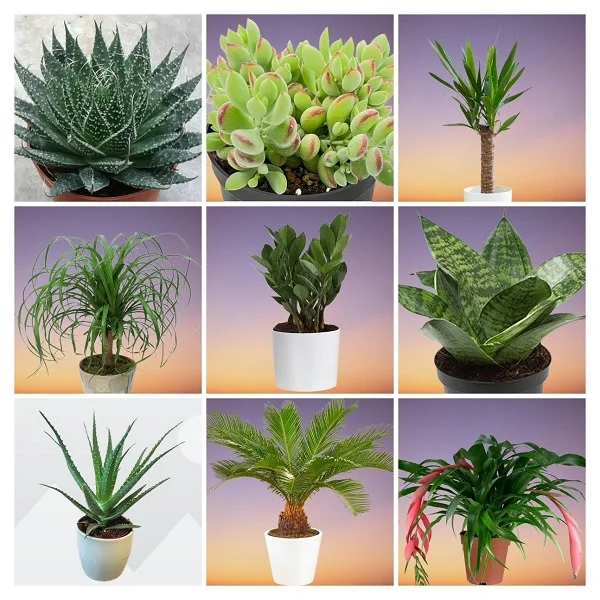How to Grow, Care and Propagate Devil's Backbone Kalanchoe (Kalanchoe daigremontiana)
Some links in this post may be affiliate links
Devil's Backbone Kalanchoe (Kalanchoe daigremontiana) does well in bright light to full sunlight, average warmth, moderate humidity and moderately moist, rich, well-drained, succulents soil coupled with monthly feeding in the growing season.
Kalanchoe daigremontiana also called Mother of Thousands Kalanchoe, Alligator Plant or Mexican Hat Plant is one of the popular Kalanchoe varieties and bears thick fleshy leaves with numerous bulbils on the teeth.
The leaves in Kalanchoe daigremontiana vary in size, color and shape. They are dark-green to purplish-green with brown-red spots and held up by 2 inches long petioles.
The common name, 'Mother of Thousands Kalanchoe', is in reference to the plantlets that form along the edges of the leaves.
Whereas, these plantlets make propagation of this plant easy, they cause it to be invasive in some regions as they easily drop and begin to grow anywhere there is soil. It is recommended to grow this plant in a container to minimize spread.
On account of their love for sunlight, Mother of Thousands Kalanchoe and its cousins Kalanchoe blossfeldiana (Flaming Katy), Kalanchoe tomentosa (Panda Plant) and Kalanchoe uniflora (Trailing Kalanchoe) are some of the best succulents for full sun conditions.

Botanical name: Kalanchoe daigremontiana
Synonmy: Byrophyllum daigremontianum, Kalanchoe daigremontianum
Family: Crassulaceae
Common names: Devil's Backbone Kalanchoe, Mother of Thousands Kalanchoe, Alligator Plant, Mexican Hat Plant
Origin
Kalanchoe daigremontiana is native to southwest Madagascar.
Size
Mother of Thousands Kalanchoe can grow to a height of about 3 feet and the leaves are about 8 inches long.
Flower
Alligator Plant flowers are greyish-pink or reddish to purple and bell-shaped. They are umbrella-like terminal inflorescences which appear in summer after which tiny follicles containing the seeds are formed.
Toxicity
iNaturalist.org indicates that, Devil's Backbone Kalanchoe like other plants in the Bryophyllum subgenus contains a very toxic steroid called daigremontianin which is toxic to both humans and pets. Keep the plant away from the reach of children and pets to prevent any mishaps.
Where to Buy
Are you looking to acquire these plants for your collection? You may acquire Mother of Thousands Kalanchoe online from Etsy (Link to Etsy).
Kalanchoe daigremontiana Care Indoors
Devil's Backbone Kalanchoe (Kalanchoe daigremontiana) does well in bright light to full sunlight, average warmth of 16-260C, moderate humidity of 50-55% and moderately moist, rich, well-drained succulents soil coupled with monthly feeding in the growing season.
Kalanchoe daigremontiana requires annual repotting for the young plants but mature plants only need repotting when they become pot-bound. Pruning is necessary to keep the plant neat and tidy. Keep reading for more on these growing conditions and how to achieve them.

Watering
Water Devil's Backbone Kalanchoe thoroughly during the growing season and allow the top 2-3 inches of soil to dry out between waterings.
Decrease watering significantly in the cold season as growth is minimal at this time but do not let the soil dry out completely.
Make sure that the pot has a drainage hole to prevent the soil from getting soggy as it can lead to root-rot and death of the plant.
Avoid wetting the leaves as it can lead to rotting. Water from the bottom instead. Being a tropical plant, cold water will cause it to go into shock. Therefore, always water it with water that is at room temperature.
Light Requirements
Devil's Backbone Kalanchoe grows best in bright light to full sunlight. Keep it away from hot midday sunshine to prevent scorching.
It can be grown under grow lights where natural light is inadequate. Take a look at these full spectrum grow lights on Amazon.
Regularly rotate the pot to ensure that the plant receives enought light on all sides for even growth.
If you choose to grow your Mother of Thousands Kalanchoe outdoors, gradually acclimate it and place it in a shaded place to avoid scorching the leaves.
Temperature and Humidity
Average warmth of 16-260C is ideal for Devil's Backbone Kalanchoe. The sudden change in temperature between day and night is excellent for this succulent plant as it mimicks its natural environment.
Keep the Mother of Thousands Kalanchoe away from cold drafts to avoid sudden drops in temperature as they can lead to leaf drop and reduced growth.
Devil's Backbone Kalanchoe has no need for extra humidity. Average room humidity of 50-55% is adequate for this plant. Ocassionally clean the leaves by damp-wiping with a soft cloth to get rid of dust and also discourage pest and disease infestations. Ensure that there is good air circulation to prevent fungal diseases.
Fertilizer
Feed Devil's Backbone Kalanchoe monthly during the growing period with a balanced, liquid fertilizer for lush growth. Do not feed in the cold season as growth is minimal at this time and feeding at this time can cause fertilizer burn.
Potting Medium
The best potting medium for Devil's Backbone Kalanchoe should be rich in organic matter, loose and free-draining to avoid getting soggy soil. The soil should be loose enough to allow water to drain out fast enough. Cactus and succulents mix is ideal for the plant.
Repotting
Repot the young Devil's Backbone Kalanchoe at the beginning of the growing season. Use a shallow rather than a deep pot as the plant has shallow roots.
The pot should be only 1 size larger than the current one. Ensure the pot has a drainage hole to avoid getting soggy soil as it can result in root-rot. A clay pot is preferable as it is porous which allows the soil to dry out faster, therefore, preventing it from getting soggy. Check out these terracotta pots with saucer on Amazon.
Pruning
Pruning Devil's Backbone Kalanchoe requires the removal of dead and diseased leaves to maintain the plant neat and tidy.
Propagation
Devil's Backbone Kalanchoe (Kalanchoe daigremontiana) can be propagated at the beginning of the growing season from plantlets that form along the edges of the plant.
It is important to note that Mother of Thousands Kalanchoe is a monocarpic plant which means it flowers only once and then dies. The plant takes about 2 to 5 years to mature.
However, it produces numerous plantlets which develop into new plants. These plantlets have roots attached and they root easily.
How to propagate Devil's Backbone Kalanchoe from plantlets
Carefully detach the plantlets from the mother Devil's Backbone Kalanchoe while ensuring that they have adequate roots.
Immediately, plant the plantlets in moist, free-draining soil in small holes. Only the roots should lightly touch the soil.
Slightly firm the soil around the roots and cover the set up with clear polythene to raise humidity inorder to hasten establishment.
Position the set up in a warm, well-lit place away from direct sunlight to avoid cooking the plants. Water sparingly, only when the soil is dry.
Ensure that the rooting container has adequate drainage to avoid getting the soil soggy as it can lead to rotting.
Once the Mother of Thousands Kalanchoe plantlets are well established, remove the plastic cover and pot them in individual pots.
Place the new Mexican Hat Plants in a warm, brightly-lit place and begin routine care.
Related: 5 Easy Ways to Propagate Kalanchoe (Kalanchoe Propagation)

Kalanchoe daigremontiana Problems with Remedies
Devil's Backbone Kalanchoe (Kalanchoe daigremontiana) problems include dropping leaves, drooping leaves, leggy growth, rotting, yellowing, pests and diseases among others. Keep reading for more on these problems, their remedies and solutions.
Pests
Devil's Backbone Kalanchoe is rarely attacked by pests but weak plants can be infested by mealy bugs and scale insects. Isolate the affected plant to reduce spread to the rest of the plants and treat it for the pests.
Falling (dropping) leaves
Devil's Backbone Kalanchoe falling (dropping) leaves are due to incorrect watering; either overwatering or underwatering. Water the plant liberally during the growing season and allow the top 2-3 inches of soil to dry out between waterings to keep the soil moderately moist.
Significantly cut down on watering during the cold season but never allow the soil ball to dry out completely. Avoid soggy soil by ensuring that the pot has a drainage hole and that the soil is free-draining. Learn more on how to water houseplants correctly.
Leggy growth
Devil's Backbone Kalanchoe leggy growth is an indication that the lighting is inadequate. This is an attempt by the plant to reach for the light. Move the plant to a brighter spot where it will receive bright light with at least 4-6 hours direct sunlight or instal a grow light if the natural lighting is not enough. Check out this guide on understanding light for houseplants.
Rotting base, yellowing and shriveled leaves
Devil's Backbone Kalanchoe rotting at the base followed by yellowing and shriveled leaves is an indication of basal stem-rot disease which is brought about by overwet conditions. Avoid soil soggy by ensuring that the pot has a drainage hole and that the soil is free-draining.
Drooping leaves
Devil's Backbone Kalanchoe drooping leaves is due to underwatering. Immediately water the plant thoroughly and it should perk up. Thereafter, water the plant thoroughly during the growing season while allowing the top 2-3 inches of soil to dry out between waterings. During the cold season, water very infrequently but never allow the soil to dry our completely.
You liked it? Share on social media.
Related Content
Amazon Associates Disclosure
Homeplantsguide.com is a participant in the Amazon Services LLC Associates Program, an affiliate advertising program designed to provide a means for sites to earn advertising fees by advertising and linking to amazon.com.





